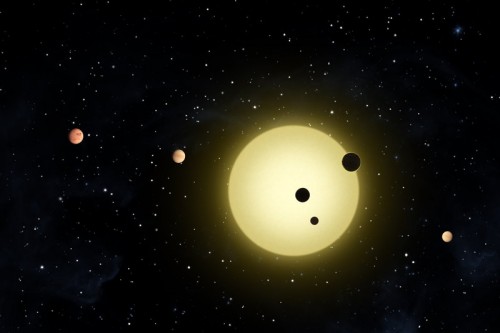At a panel held at NASA headquarters, the agency's chief scientist Ellen Stephan said: "We're not talking about little green people, we're talking about little bacteria."

Strong evidence of the existence of aliens will be discovered within a decade and absolute proof within 20-30 years, says NASA's chief scientist.
"We know where to look, we know how to look," says Ellen Steffen during a panel that dealt with NASA's search for alien life forms and worlds suitable for life. "In most cases, we have the technology and we are on the way to implementing it."
However, she immediately added: "We're not talking about little green people, we're talking about little bacteria."
Her colleague John Grunsfeld, a former astronaut and NASA's assistant administrator for the Science Mission Administration, agrees. "I believe that within one generation we will discover life elsewhere in the solar system, either on one of the icy moons (of Jupiter or Saturn AB) and a generation later, on a planet orbiting a nearby star." Grunsfeld says.
Jeffrey Newmark, the interim director of the heliophysics field at NASA added: "It's not a question of if but when."
NASA Planetary Missions Director Jim Green added that in the solar system, evidence of the existence of an ocean for 1.2 billion years was discovered in the northern hemisphere of Mars, adding that "Mars was quite similar to Earth in the habitable zone of the solar system."
Green also added that evidence of water has been discovered on the moons of the gas giants, apparently a warm subsurface ocean exists on the Saturnian moon Enceladus and scientists have confirmed that the fair moon Ganymede has a salty subsurface ocean. The scientists estimate that the presence of water is one possible sign of life.
"Curiosity showed that the Earth is not unique in the solar system in terms of the conditions for life, while Kepler showed that the solar system is not unique for the Milky Way and in fact in the entire universe full of solar systems.
The way to search for life on planets outside the solar system is by detecting gases that are created as a result of air pollution on distant planets. A high rate of oxygen is also evidence of plant-like life. Recently it has also been discovered that some relatively close planets and their moons may have life-supporting environments based on their size and positions relative to the planet's habitable zone.
- Kepler first discovered evidence of rocky planets in the habitable zone of the star Kepler 11
- Complex organic molecules - the condition for life - were discovered in the nebula of a nascent solar system
- Hello, is there anyone out there?
- Want to discover life in space? Look for methane

6 תגובות
Skeptic, in the history of science there have been so many cases where all our theories have been turned upside down, and replaced or upgraded to new theories, that I would not bet on a field that cannot even be said to be in its infancy, because really the technological developments that allow serious research on the subject have only existed for a few years , and even still in development.
On Mars, they have not yet tested all the caves that we know exist there, and are a possible habitat for life with great potential. As long as no people have landed there, the ability to conduct in-depth and comprehensive research is small. The possibilities with robotic landers today is quite limited. I also feel that it is not fast enough, but there is no choice, the developments take a long time...
Definitely a serious advance in our capabilities, but of course until we find life we cannot of course claim to have found life,
It may be possible to find signs that can indicate life that is familiar to us
If they exist in another place besides the earth by the new means that are being developed today,
This does not mean that they will find this life, only that there will be tools that are able to show us about signs that according to the best of our understanding
They are the product of life of the kind we are familiar with and not a natural geological phenomenon on the surface of a distant planet,
In our "nearest" neighborhood, the solar system in which we live, there may be life on one of the moons, perhaps the planet Mars
But it can only be tested by sending a suitable satellite/lander and it's very complicated. I don't currently know of a plan for the landing
Ride on the moon Europe for example
Or Titan, these are just satellites that are designed for inspection from above,
On Mars the chance for life is likely to exist if it exists deep underground it requires drilling
I don't know of a serious plan right now to test this,
Of course, there could suddenly be some kind of surprise with what currently exists there, but after a few years
that the vehicles turn around there, the chance of surprise is not great.
And here is my prediction for the coming years: In Eilat, the port will be expanded, there will be a train to Eilat, and in addition to swimming with dolphins and sharks, it will be possible to wade with manatees. Government enterprises will be established in high-tech and defense industries. An investment bank will be established in Tiberias, a government initiative. 20 million people will live in Israel and there will be more public housing .
One thing is certain already now and is gaining validity from year to year - there is no intelligent life at NASA...
Apparently NASA needs an extra budget. Every time they look for money budgets they "discover signs of life".
Bet on space, yes many